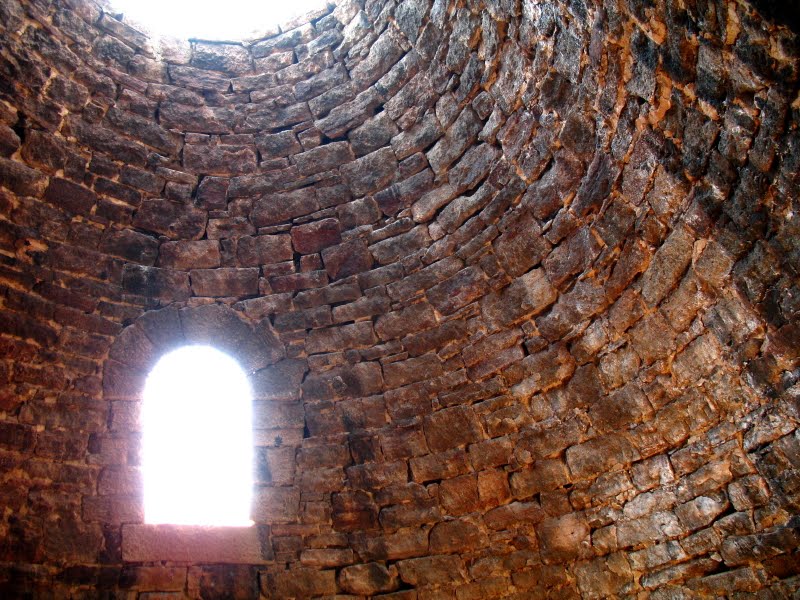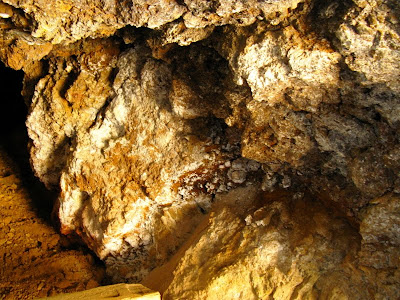The next place on my
continuing find-a-thesis journey was the silver mining district of Belmont.

Part of the Tonopah 1:250,000 sheet via
MSRMaps courtesy
USGS.
A little less than half way down the Pole Line Road to Tonopah, where the Shoshone Mountains nearly merge with the Toiyabe Range, I took one of several dirt roads that show up on the Tonopah 2° sheet as dashed, gray lines. I'm not sure which road I took, and as you can see from the map above, there are quite a few dashed-gray roads. In fact, even today there are more old roads than show on any old or new maps.

Looking down the Pole Line Road toward the Hall Moly Mine
in the San Antonio Mountains.

None of the trails or byways promised to allow me to easily skirt the many ups and downs on the alluvial fans coming out of the south end of the mountains — from Ione Wash and Cloverdale Creek on across to the drainages of Cottonwood and Peavine Creeks. Ultimately, if I could make it, I would have to traverse about 25 miles of alluvial fan to attain Highway 8A south of Round Mountain. These roads are now, for the most part, wider and smoother than they were in 1976, and most can be driven at 40 to 60 mph depending on your vehicle, the weather, and your overall driving inclination. I probably drove most of the way in my Opel at a quarter to half that speed.

By the way, the southern Shoshone Mountains and southern Toiyabe Range are made primarily of
Tertiary volcanic rocks, including this vitrophyre above poorly to moderately welded ash-flow tuff and below a thick pile of moderately to strongly welded tuff.

The sun was low in the western sky when I left Pole Line Road, and as I made my way across the channeled fans and through scattered rocky zones, it seemed to sink rapidly. At the time, I had rarely driven on dirt, and I wondered constantly whether the road would get worse or come to some impasse. Even today, in a 4WD truck, this part of the road is not fast, requiring speeds of 15 to 30 mph. Could I have possibly gone that fast in my light blue sedan?

At least it's not an Opel!
The road seemed endless. I drove up and down and over and across incised dry washes, one after the other, on and on. I saw a couple other vehicles now and then — on other roads — and I saw a ranch or two in the distance. I felt conspicuous and out of place. I worried that I might get stuck in the sagebrush and soft dirt on the side of the road if I tried to turn around — and the way south on Pole Line to Tonopah and then back north on Highway 8A would be appreciably longer — so I kept going. I kept going as the light turned orangey yellow, not knowing for sure if I was really on the right road, or if the road would go through, deteriorate, or disappear altogether.

The good road as it heads west toward San Antone Ranch.
At some point, a better road came in from the south, maybe near San Antone Ranch, which, as it turned out, was only 9 miles from pavement. Had there been a better and more direct route all along?

Southern Toiyabe Range volcanic rocks and Peavine Ranch.
Through the entire Ione Wash to Big Smoky Valley crossing, I saw several ranches, some distant, some near. The ranch at the mouth of Peavine Creek is appropriately known as Peavine Ranch; it comes into view as one nears the pavement at old Highway 8A.

Highway 8A looking north near the Manhattan turnoff.
Finally, I made it across the valley to pavement at Highway 8A, I turned north, then east onto Highway 69, the Manhattan Road (now S.R. 377). I drove into the
small town of Manhattan near dusk, then east over a low pass, and then north to Belmont on the east side of the Toquima Range.

It was too dark to do much at
Belmont, so I drove north on the wide, bladed, Monitor Valley Road (AKA Old Belmont Road, previously old Highway 82, now unnumbered). I found a tiny place to pull off and set up a little camp behind my car. I didn’t really like sleeping so close to a main road, but my car gave me zero access to any other site, and it was dark, past time to stop. I ate what I had, wrapped my space blanket around my newly bought (though old), army-issue, goose-feather sleeping bag and settled down on the dirt behind my car for the night. The bag was sold to me as a down bag, good to 20°F. Ha! Nowhere near!

Now why didn't I stop at this bar?
I awoke the next morning covered by a dusting of snow, my bag and clothes wet, inside and out. While chomping on a granola bar or two, I drove on dirt to the old workings. By means of the early morning light, I looked around some of the mine dumps
south of the old Combination Mill (zoom out to see what I mean about 1:100,000 topos showing very few old workings). I remember seeing lots of quartz vein material, quartz lying around everywhere. Hmm... interesting area!

Combination Mill ruins.
One thing I didn't realize at the time, was that had I gotten a tour of the old courthouse in Belmont, the former county seat of Nye County, I would have seen
this piece of graffiti, purportedly left by C.Manson and family in 1969, seven years prior to my arrival on the scene. More importantly though, the
Belmont Courthouse and
other remaining structures are worth traveling across Nevada to see, so put the place on your list!
[Don't confuse the town of Belmont in Nye County with the
Belmont Mill in White Pine County, which is also worth seeing.]

Old building at Belmont.
I had the feeling that the area was too crowded, with the main dirt road going by, with the small community of Belmont just over the hill, and with the town of Manhattan just over the mountain. It would ultimately take me quite some time to feel comfortable working in the field if there were many people around, and even now, I prefer uncrowded, back areas: the middle of so-called nowhere.
I finished up looking around the old dumps, headed back over the pass, coasted downhill through Manhattan and back to Highway 8A, and then I turned left, to cruise south toward Route 6. My route would take me through Tonopah, past the Divide district, into the Palmetto Mountains, and on to Silver Peak.
To be continued someday...


















































